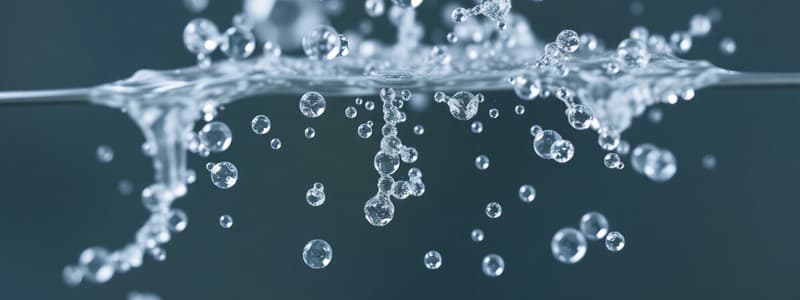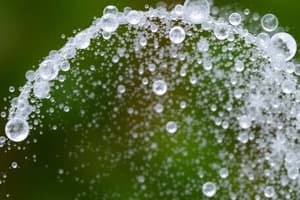Podcast
Questions and Answers
Which statement accurately describes the relationship between particle speed and energy during evaporation?
Which statement accurately describes the relationship between particle speed and energy during evaporation?
- Slower particles possess more energy, facilitating their escape from the liquid surface.
- Only particles at a specific, uniform speed can evaporate effectively.
- Particle speed has no correlation with energy levels during evaporation.
- Faster particles possess more energy, increasing their likelihood of escaping the liquid surface. (correct)
Evaporation causes cooling because high-energy particles leave the liquid, which increases the average energy of the remaining particles.
Evaporation causes cooling because high-energy particles leave the liquid, which increases the average energy of the remaining particles.
False (B)
Explain why applying perfume to the skin typically results in a cooling sensation.
Explain why applying perfume to the skin typically results in a cooling sensation.
Perfumes have weaker forces between their particles so they evaporate faster than water. This rapid evaporation removes thermal energy from the skin more quickly, causing a cooling sensation.
The process of sweat evaporation cools the skin because thermal energy transfers from the skin to the cooler ______.
The process of sweat evaporation cools the skin because thermal energy transfers from the skin to the cooler ______.
Match the following liquids with their evaporation characteristics:
Match the following liquids with their evaporation characteristics:
Why does high humidity hinder the process of cooling through sweat evaporation?
Why does high humidity hinder the process of cooling through sweat evaporation?
In an air cooler that uses evaporation, what is the primary function of the sponge soaked in water?
In an air cooler that uses evaporation, what is the primary function of the sponge soaked in water?
Increasing the surface area of a liquid will decrease the rate of evaporation.
Increasing the surface area of a liquid will decrease the rate of evaporation.
Flashcards
Evaporation
Evaporation
Change of state from liquid to gas.
Water Particle Motion
Water Particle Motion
Water particles move randomly in different directions and speeds.
Kinetic Energy
Kinetic Energy
Faster particles have more of this.
Temperature Definition
Temperature Definition
Signup and view all the flashcards
Evaporation and Cooling
Evaporation and Cooling
Signup and view all the flashcards
Sweat Cooling
Sweat Cooling
Signup and view all the flashcards
High Humidity Effect
High Humidity Effect
Signup and view all the flashcards
Intermolecular Forces
Intermolecular Forces
Signup and view all the flashcards
Study Notes
- Evaporation is the change of state from liquid to gas.
- Key words include porous and random
Evaporation Process
- Water boils at 100°C, but it can still evaporate at temperatures like 15°C.
- Water particles move randomly in different directions.
- The speed of water particles is also random and unpredictable.
- Faster particles have more energy.
- Some particles have enough energy to escape the liquid surface.
- Some particles return to the liquid, while others do not.
Evaporation and Cooling
- Temperature measures the average energy of particles.
- Water particles have different energy levels.
- High energy particles that escape water lower the average energy of the remaining particles.
- Evaporation results in cooling.
- Feeling cooler after swimming is due to evaporation on the skin.
- Energy for water to change from liquid to gas comes from the skin.
- The loss of thermal energy from the skin causes cooling.
Cooling Mechanism
- Skin produces sweat when it is too hot.
- Sweat is initially the same temperature as the skin.
- Evaporation lowers the temperature of sweat.
- Thermal energy transfers from skin to cooler sweat.
- The process continues to lower the skin temperature.
Alternative Cooling Methods
- Some animals use water to cool down.
- Water evaporation provides a cooling effect.
Humidity Effects
- High humidity can prevent sweat evaporation.
Water Coolers
- Water coolers can be made from porous clay.
- Porous means water can slowly soak through something.
- When filled with water, some water soaks through the clay to the outside.
- This water evaporates into the surrounding air, cooling the water inside.
- Some air coolers use the evaporation of water to cool air.
- The air cooler contains a sponge soaked in water.
- A fan blows warm air of the room through the sponge.
Other Liquids
- Different liquids have different forces holding their particles together.
- Some liquids have weaker forces than water, while others have stronger forces.
- Perfumes have weaker forces between particles, so they evaporate quickly.
- Perfumes feel colder than water when applied to the skin because they evaporate faster, removing more thermal energy.
- Other liquids, like liquid soap, have stronger forces between particles.
- Liquid soap evaporates more slowly than water, so water feels colder.
- Water evaporates faster than liquid soap, removing thermal energy faster.
Studying That Suits You
Use AI to generate personalized quizzes and flashcards to suit your learning preferences.
Related Documents
Description
Explore the process of evaporation, where liquids change to gas. Water particles move randomly, with some escaping the surface. Evaporation cools because escaping high-energy particles lower the remaining particles' average energy, drawing thermal energy from the skin.




